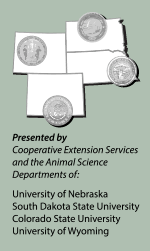Incorporating a Yearling Enterprise with a Cow-calf Operation
Grazing stockers can complement a cow-calf enterprise, but requires different managmeent skills.
LOVELAND, Colo. (Nov. 18, 2015) — “There are good reasons for adding stockers to an existing cow-calf operation,” claims Mark Frasier, an eastern Colorado cattleman whose Fort Morgan-based operation has long included a cow herd and a yearling enterprise. Frasier talked about the potential advantages of having both, and the challenges, during the 24th Range Beef Cow Symposium Nov. 17-19 in Loveland, Colo.

Mark Frasier.
Frasier said grazing yearlings is an attractive second enterprise, from a grazier’s point of view, and can complement a cow herd. That’s because nearly every ranching operation experiences fluctuations in forage availability, seasonally and between years of timely, abundant rain vs. drought. When growing conditions are better than average, a ranch may have excess forage, but a shortage could force a cow outfit to destock and lose part of its genetic base. Grazing yearlings can allow more flexibility.
According to Frasier, a conservative approach is to maintain the number of cows that the ranch can support during years of lean forage supply without buying extra feed. Yearlings are then purchased to graze the forage that, in most years, would be in excess to the cow herd’s needs.
“Since stockers are market cattle and not permanent, they make a flexible tool to increase ranch inventory on a temporary basis. When grass is abundant, you buy. When it isn’t, you sell or simply elect not to bring stockers to the ranch,” said Frasier. “Stockers lend flexibility and diversity, allowing more efficient use of forage.”
However, Frasier reminded his audience that grazing strategies for cows differ from those needed for yearlings. While cow nutritional requirements must be adequate for reproduction and producing an acceptable calf at weaning, the baseline for cow-calf nutrition is largely about maintenance. With stockers, it’s all about gain. Forage resources must be sufficient in quantity and of high quality to add frame and flesh to young cattle with high nutrient requirements.
In Frasier’s opinion, the most significant challenge to adding stockers to a cow-calf operation is the difference in management skills and aptitudes required by each. He noted how the cow-calf business model is “zero-based,” with incremental costs accumulated from conception through weaning. If cumulative costs are less than gross revenue generated by weaned calves, the enterprise is profitable.
By contrast, the yearling stocker model is “margin-based,” and profitability is dependent upon the cost of gain. The purchase price of stockers and their selling price don’t matter, so long as the marginal value of each pound of gain exceeds its cost.
“The economic models for each enterprise is different and have to be thought through differently,” stated Frasier, emphasizing that marketing skills are paramount to the yearling enterprise. He called the use of forward-pricing tools or hedging contracts a necessary consideration to manage risk.
Frasier said cows and stockers can be mutually complementary, but they are different kinds of businesses that require an operator to have the skill sets to manage both successfully.
Editor’s Note: This summary was written under contract or by staff of the Angus Journal®, which retains the copyright. To request to reprint this article, contact Shauna Rose Hermel, editor, at 816-383-5270. PowerPoints are posted with permission of the presenter and may not be reproduced in whole or in part without the express permission of the presenter. Angus Journal claims copyright to this web site as presented. We welcome educational venues and cattlemen to link to this site as a service to their audience.
The Angus Journal's coverage of the event is made possible through collaboration with the event committee and sponsorship of LiveAuctions.tv. For questions about this site, or to notify us of broken links, click here. Look for additional coverage in the Angus Journal, the Angus Beef Bulletin, the Angus Journal Daily, the Angus Beef Bulletin EXTRA and Angus TV.


